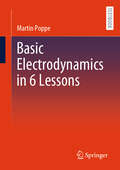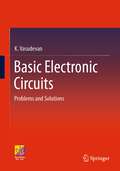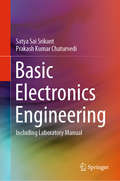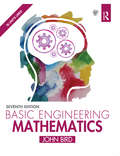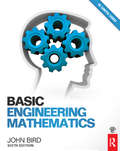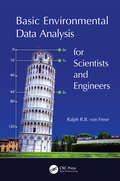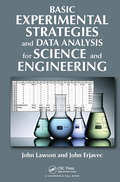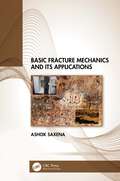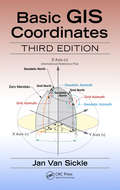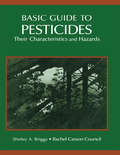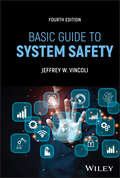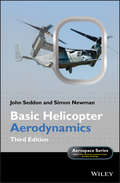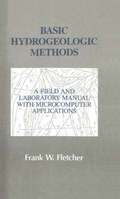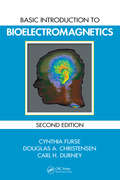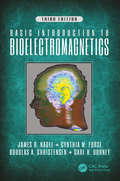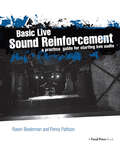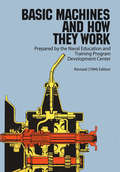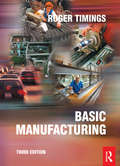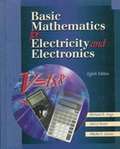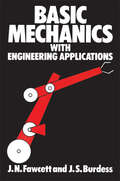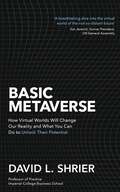- Table View
- List View
Basic Electrodynamics in 6 Lessons
by Martin PoppeThis book explains why there are different variants of Maxwell's equations and the physical meaning of the quantities they contain. It also shows how the equations for static electric and magnetic potentials are derived from Maxwell's equations. Matter exposed to the field is an integral part of the discussion. Multipole developments are justified and derived. Furthermore, the potential for simplification in formulating dynamical theory as gauge field theory is explained. The laws of optics are derived from those of electrodynamics. Justifications are provided for quasi-stationary calculations, limits are formulated, and technical counterexamples are shown.
Basic Electronic Circuits: Problems and Solutions
by K. VasudevanThis book contains entirely numerical problems and fully worked solutions in the topic of basic electronic circuits and it is designed for entry-level undergraduate courses as a supplement to standard textbooks and references. Each chapter contains interesting numerical problems with fully worked solutions to illustrate the approach of problem solving techniques for electronic circuits. The book is written in a lucid manner so that students are able to understand the realization behind the mathematical concepts which are the backbone of this subject. The book will benefit students who are taking introductory courses in electronic circuits and devices.
Basic Electronics Engineering: Including Laboratory Manual
by Prakash Kumar Chaturvedi Satya Sai SrikantThis book is primarily designed to serve as a textbook for undergraduate students of electrical, electronics, and computer engineering, but can also be used for primer courses across other disciplines of engineering and related sciences. The book covers all the basic aspects of electronics engineering, from electronic materials to devices, and then to basic electronic circuits. The book can be used for freshman (first year) and sophomore (second year) courses in undergraduate engineering. It can also be used as a supplement or primer for more advanced courses in electronic circuit design. The book uses a simple narrative style, thus simplifying both classroom use and self study. Numerical values of dimensions of the devices, as well as of data in figures and graphs have been provided to give a real world feel to the device parameters. It includes a large number of numerical problems and solved examples, to enable students to practice. A laboratory manual is included as a supplement with the textbook material for practicals related to the coursework. The contents of this book will be useful also for students and enthusiasts interested in learning about basic electronics without the benefit of formal coursework.
Basic Electronics for Scientists and Engineers
by Dennis L. EgglestonIdeal for a one-semester course, this concise textbook covers basic electronics for undergraduate students in science and engineering. Beginning with the basics of general circuit laws and resistor circuits to ease students into the subject, the textbook then covers a wide range of topics, from passive circuits through to semiconductor-based analog circuits and basic digital circuits. Using a balance of thorough analysis and insight, readers are shown how to work with electronic circuits and apply the techniques they have learnt. The textbook's structure makes it useful as a self-study introduction to the subject. All mathematics is kept to a suitable level, and there are several exercises throughout the book. Password-protected solutions for instructors, together with eight laboratory exercises that parallel the text, are available online at www. cambridge. org/Eggleston.
Basic Engineering Mathematics
by John BirdNow in its seventh edition, Basic Engineering Mathematics is an established textbook that has helped thousands of students to succeed in their exams. Mathematical theories are explained in a straightforward manner, being supported by practical engineering examples and applications in order to ensure that readers can relate theory to practice. The extensive and thorough topic coverage makes this an ideal text for introductory level engineering courses. This title is supported by a companion website with resources for both students and lecturers, including lists of essential formulae, multiple choice tests, and full solutions for all 1,600 further questions.
Basic Engineering Mathematics, 6th ed
by John BirdIntroductory mathematics written specifically for students new to engineering Now in its sixth edition, Basic Engineering Mathematics is an established textbook that has helped thousands of students to succeed in their exams. John Bird's approach is based on worked examples and interactive problems. This makes it ideal for students from a wide range of academic backgrounds as the student can work through the material at their own pace. Mathematical theories are explained in a straightforward manner, being supported by practical engineering examples and applications in order to ensure that readers can relate theory to practice. The extensive and thorough topic coverage makes this an ideal text for introductory level engineering courses. This title is supported by a companion website with resources for both students and lecturers, including lists of essential formulae, multiple choice tests, full solutions for all 1,600 further questions contained within the practice exercises, and biographical information on the 25 famous mathematicians and engineers referenced throughout the book. The companion website for this title can be accessed from www.routledge.com/cw/bird
Basic Environmental Data Analysis for Scientists and Engineers
by Ralph R.B. Von FreseClassroom tested and the result of over 30 years of teaching and research, this textbook is an invaluable tool for undergraduate and graduate data analysis courses in environmental sciences and engineering. It is also a useful reference on modern digital data analysis for the extensive and growing community of Earth scientists and engineers. Basic Environmental Data Analysis for Scientists and Engineers introduces practical concepts of modern digital data analysis and graphics, including numerical/graphical calculus, measurement units and dimensional analysis, error propagation and statistics, and least squares data modeling. It emphasizes array-based or matrix inversion and spectral analysis using the fast Fourier transform (FFT) that dominates modern data analysis. Divided into two parts, this comprehensive hands-on textbook is excellent for exploring data analysis principles and practice using MATLAB®, Mathematica, Mathcad, and other modern equation solving software. Part I, for beginning undergraduate students, introduces the basic approaches for quantifying data variations in terms of environmental parameters. These approaches emphasize uses of the data array or matrix, which is the fundamental data and mathematical processing format of modern electronic computing. Part II, for advanced undergraduate and beginning graduate students, extends the inverse problem to least squares solutions involving more than two unknowns. Features: Offers a uniquely practical guide for making students proficient in modern electronic data analysis and graphics Includes topics that are not explained in any existing textbook on environmental data analysis Data analysis topics are very well organized into a two-semester course that meets general education curriculum requirements in science and engineering Facilitates learning by beginning each chapter with an ‘Overview’ section highlighting the topics covered, and ending it with a ‘Key Concepts’ section summarizing the main technical details that the reader should have acquired Indexes many numerical examples for ready access in the classroom or other venues serviced by electronic equation solvers like MATLAB®, Mathematica, Mathcad, etc. Offers supplemental exercises and materials to enhance understanding the principles and practice of modern data analysis
Basic Experimental Strategies and Data Analysis for Science and Engineering
by John Lawson John ErjavecEvery technical investigation involving trial-and-error experimentation embodies a strategy for deciding what experiments to perform, when to quit, and how to interpret the data. This handbook presents several statistically derived strategies which are more efficient than any intuitive approach and will get the investigator to their goal with the fewest experiments, give the greatest degree of reliability to their conclusions, and keep the risk of overlooking something of practical importance to a minimum. Features: Provides a comprehensive desk reference on experimental design that will be useful to practitioners without extensive statistical knowledge Features a review of the necessary statistical prerequisites Presents a set of tables that allow readers to quickly access various experimental designs Includes a roadmap for where and when to use various experimental design strategies Shows compelling examples of each method discussed Illustrates how to reproduce results using several popular software packages on a companion web site Following the outlines and examples in this book should quickly allow a working professional or student to select the appropriate experimental design for a research problem at hand, follow the design to conduct the experiments, and analyze and interpret the resulting data. John Lawson and John Erjavec have a combined 25 years of industrial experience and over 40 years of academic experience. They have taught this material to numerous practicing engineers and scientists as well as undergraduate and graduate students.
Basic Fracture Mechanics and its Applications
by Ashok SaxenaThis textbook provides a comprehensive guide to fracture mechanics and its applications, providing an in-depth discussion of linear elastic fracture mechanics and a brief introduction to nonlinear fracture mechanics. It is an essential companion to the study of several disciplines such as aerospace, biomedical, civil, materials and mechanical engineering. This interdisciplinary textbook is also useful for professionals in several industries dealing with design and manufacturing of engineering materials and structures. Beginning with four foundational chapters, discussing the theory in depth, the book also presents specific aspects of how fracture mechanics is used to address fatigue crack growth, environment assisted cracking, and creep and creep-fatigue crack growth. Other topics include mixed-mode fracture and materials testing and selection for damage tolerant design, alongside in-depth discussions of ensuring structural integrity of components through real-world examples. There is a strong focus throughout the book on the practical applications of fracture mechanics. It provides a clear description of the theoretical aspects of fracture mechanics and also its limitations. Appendices provide additional background to ensure a comprehensive understanding and every chapter includes solved example problems and unsolved end of chapter problems. Additional instructor support materials are also available.
Basic GIS Coordinates
by Jan Van SickleCoordinates are integral building tools for GIS, cartography, surveying and are vital to the many applications we use today such as smart phones, car navigation systems and driverless cars. Basic GIS Coordinates, Third Edition grants readers with a solid understanding of coordinates and coordinate systems and how they operate as well as valuable insight into what causes them to malfunction. This practical and comprehensive guide lays out the foundation of a coordinate system and the implications behind building it as it elaborates on heights, two coordinate systems, and the rectangular system.The previous editions described horizontal and vertical datums such as the North American Datum 1983 (NAD 83) and the North American Vertical Datum 1988 (NAVD 88). Both will be replaced in 2022 or thereabouts. The National Geodetic Survey (NGS) plans to replace NAD83 with a new semi-dynamic terrestrial reference frame for North America and a new vertical datum will replace NAVD88. The foundation of the new vertical datum will be a temporally tracked gravimetric geoid. The interim period is intended to smooth the transition to the new paradigm and this new edition explores the changes and provides assistance in understanding them.
Basic Guide To Pesticides: Their Characteristics & Hazards
by Rachel Carson Counsel Inc.This work contains physical properties of over 700 pesticides and transformation products and contaminants. It can be used by the layman with minor questions or by the specialist needing in-depth references. Facts have been arranged so that one does not have to read through lengthy material.
Basic Guide to System Safety
by Jeffrey W. VincoliThis book provides guidance on including prevention through design concepts within an occupational safety and health management system. Through the application of these concepts, decisions pertaining to occupational hazards and risks can be incorporated into the process of design and redesign of work premises, tools, equipment, machinery, substances, and work processes including their construction, manufacture, use, maintenance, and ultimate disposal or reuse. These techniques provide guidance for a life-cycle assessment and design model that balances environmental and occupational safety and health goals over the life span of a facility, process, or product.The new edition is expanded to include primer information on the use of safety assurance techniques in design and construction.
Basic Guide to System Safety
by Jeffrey W. VincoliBASIC GUIDE TO SYSTEM SAFETY Instructional guide applying “prevention through design” concepts to the design and redesign of work premises, tools, equipment, and processes Basic Guide to System Safety provides guidance on including prevention through design concepts within an occupational safety and health management system; through the application of these concepts, decisions pertaining to occupational hazards and risks can be incorporated into the process of design and redesign of work premises, tools, equipment, machinery, substances, and work processes, including their construction, manufacture, use, maintenance, and ultimate disposal or reuse. These techniques provide guidance for a life-cycle assessment and design model that balances environmental and occupational safety and health goals over the lifespan of a facility, process, or product. The updated Fourth Edition reflects current and emerging industry practices and approaches, providing an essential periodic review of the text to ensure its contents adequately meet the requirements of academia as well as other users in the occupational safety and health profession. The book also features a new chapter on Prevention through Design (PtD) and how it is linked to System Safety Engineering and Analysis. Topics covered in Basic Guide to System Safety include: System safety criteria, including hazard severity and probability, the hazard risk matrix, and system safety precedence System safety efforts, including closed-loop hazard tracking systems, accident risk assessments, and mishap, accident, and incident reporting Fault or functional hazard analysis, management oversight and risk trees, HAZOP and what-if analyses, and energy trace and barrier analysis (ETBA) Sneak circuit analysis, including types and causes of sneaks, input requirements, and advantages and disadvantages of the technique Providing essential fundamentals for readers who may not have a background or pre-requisite in the subject, Basic Guide to System Safety is an ideal introductory resource for the practicing safety and health professionals, along with advanced students taking industrial safety courses.
Basic Helicopter Aerodynamics
by Simon Newman John M. SeddonBasic Helicopter Aerodynamics is widely appreciated as an easily accessible, rounded introduction to the first principles of the aerodynamics of helicopter flight. Simon Newman has brought this third edition completely up to date with a full new set of illustrations and imagery. An accompanying website www.wiley.com/go/seddon contains all the calculation files used in the book, problems, solutions, PPT slides and supporting MATLAB® code.Simon Newman addresses the unique considerations applicable to rotor UAVs and MAVs, and coverage of blade dynamics is expanded to include both flapping, lagging and ground resonance. New material is included on blade tip design, flow characteristics surrounding the rotor in forward flight, tail rotors, brown-out, blade sailing and shipborne operations.Concentrating on the well-known Sikorsky configuration of single main rotor with tail rotor, early chapters deal with the aerodynamics of the rotor in hover, vertical flight, forward flight and climb. Analysis of these motions is developed to the stage of obtaining the principal results for thrust, power and associated quantities. Later chapters turn to the characteristics of the overall helicopter, its performance, stability and control, and the important field of aerodynamic research is discussed, with some reference also to aerodynamic design practice.This introductory level treatment to the aerodynamics of helicopter flight will appeal to aircraft design engineers and undergraduate and graduate students in aircraft design, as well as practising engineers looking for an introduction to or refresher course on the subject.
Basic Hydrogeologic Methods: A Field and Laboratory Manual with Microcomputer Applications
by Frank FletcherThe approach of this book is how-to-do and hands-on. Its purpose is to provide clear, step-by-step instruction in many of the fundamental methods of hydrogeologic investigation. These methods include both 1) the traditional techniques of data analysis, such as mathematical computation by electronic calculator and construction of graphs by hand-plotting, and 2) microcomputer techniques employing electronic spreadsheets, graphing and gridding and contouring software. The microcomputer methods employ commercial software such as Lotus 1-2-3. Microsoft Excel, Quattro-Pro, Golden Software's Grapher and Surfer, and Geraghty and Miller's AQTESOLV. Although familiarity with any of the applications is helpful, the instructions in this manual assume no prior experience with them. Basic Hydrogeologic Methods is divided into three sections: Groundwater Occurrence and Movement, Groundwater Investigations, and Well and Aquifer Hydraulics. Each section begins with a brief summary of relevant terminology and principles. This introductory chapter is followed by a case study, which may be employed to provide a practical context for the hydrogeological methods that are described in subsequent chapters. Most of the methodological exercises culminate in an analytical product, such as data table, graph, contour map, etc., which readily serve as a focus for problem-solving activities, classroom discussions, and investigative reports. Many of the exercises present at least two investigative methods for accomplishing a particular hydrogeologic task. For example, time-drawdown graphs may be produced by a hand-plotting method or by a microcomputer method. For the professional scientist, the choice of a particular method might depend on such factors as the time available to carry out the task, the degree of accuracy required, or the availability of assessory equipment and materials.
Basic Introduction to Bioelectromagnetics
by Cynthia Furse Douglas A. Christensen Carl H. DurneyAlthough classical electromagnetic (EM) field theory is typically embedded in vector calculus and differential equations, many of the basic concepts and characteristics can be understood with precursory mathematical knowledge. Completely revised and updated, Basic Introduction to Bioelectromagnetics, Second Edition facilitates the process of interd
Basic Introduction to Bioelectromagnetics, Third Edition
by James Nagel Cynthia Furse Douglas A. Christensen Carl H. DurneyBasic Introduction to Bioelectromagnetics, Third Edition, is a primary source for medical technologists and life scientists seeking to understand how electromagnetic fields interact with the body, and how they are used in medical applications. Instead of the complex math commonly used when analyzing electromagnetics, this book uses graphical methods and simple equations. The third edition is updated with color graphics that show the fields in bright, clear colors. Each concept is presented with an associated discussion and application, including MRI, NMR, hyperthermia, neural stimulation, ultrasound, and cardiac pacing/defibrillation. Offering a simplified explanation of a very complex subject, this third edition provides an accessible introduction for life scientists and medical technologist on how EM fields work, what controls them, and the factors important to experimental setups and medical applications. This qualitative and illustrative book: Covers the entire frequency spectrum from direct current (DC) up through optical frequencies. Includes more than 200 illustrations, 65 in color, and 40 medical applications. Incorporates examples from real-world applications to explain concepts. Concentrates on the qualitative explanation of the key concepts, fundamental principles, and characteristic behaviors of EM fields, without complicated mathematics. Offers practical rules of thumb to understand real situations. Requires only a background in algebra, in contrast to typical EM books that require vector calculus and differential equations.
Basic Live Sound Reinforcement: A Practical Guide for Starting Live Audio
by Raven Biederman Penny PattisonAccess and interpret manufacturer spec information, find shortcuts for plotting measure and test equations, and learn how to begin your journey towards becoming a live sound professional. Land and perform your first live sound gigs with this guide that gives you just the right amount of information. Don't get bogged down in details intended for complex and expensive equipment and Madison Square Garden-sized venues. Basic Live Sound Reinforcement is a handbook for audio engineers and live sound enthusiasts performing in small venues from one-mike coffee shops to clubs. With their combined years of teaching and writing experience, the authors provide you with a thorough foundation of the theoretical and the practical, offering more advanced beginners a complete overview of the industry, the gear, and the art of mixing, while making sure to remain accessible to those just starting out.
Basic Machines and How They Work
by Naval EducationThis revised edition of an extremely clear Navy training manual leaves nothing to be desired in its presentation. Thorough in its coverage of basic theory, from the lever and inclined plane to internal combustion engines and power trains, it requires nothing more than an understanding of the most elementary mathematics. Beginning with the simplest of machines — the lever — the text proceeds to discussions of the block and tackle (pulleys and hoists), wheel and axle, the inclined plane and the wedge, the screw, and different types of gears (simple, spur, bevel, herringbone, spiral, worm, etc.). A chapter on the concept of work discusses the measurement of work, friction, and efficiency; this is followed by investigations of power, force, and pressure, with explanations of the uses of scales, balances, gauges, and barometers. The fundamentals of hydrostatic and hydraulic machines (such as the hydraulic braking system and the hydraulic press) are discussed in detail. The remaining chapters cover machine elements (bearings and springs), basic mechanisms (gear differential, couplings, cams, clutches), the internal combustion engine and power trains (including explanations of various transmission systems — synchromesh, auxiliary, etc.). Every concept is clearly defined, and discussions always build easily from elementary theory to specific applications familiar to anyone with the slightest interest in mechanics. Important concepts, machine components, and techniques are clearly illustrated in more than 200 diagrams, drawings, and cross-sections that reveal inner workings — all of these help to clarify even further an already clear and well-organized presentation. Although it was originally designed for use in U.S. Naval Training Schools, this book can be used to great advantage as a basic text in mechanical engineering in standard technical schools, and it will be immensely valuable even to lay readers who desire a basic knowledge of mechanics.
Basic Manufacturing
by Roger TimingsBasic Manufacturing has already established itself as a core text for manufacturing courses in Further Education. The new edition has been revised to be fully in line with the new Vocational GCSE in Manufacturing from Edexcel, covering the three compulsory units of this scheme, and will continue to act as a core text for Intermediate GNVQ. Coverage of the two schemes is combined throughout the text, yet each chapter clearly illustrates which sections map to which units within the two scheme specifications.The author's approach is student-centred with self-check questions and activities provided throughout. As a result, the book is well suited to independent study. It is also clearly written to appeal to students of all abilities. Review questions are provided at the end of each chapter to consolidate learning and give practice for external assessments.The third edition contains a brand new chapter to cater for the examinable part of the GCSE syllabus (Unit 3), which includes case studies in the six sectors covered in the scheme: food and drink/biological and chemical; printing and publishing/paper and board; textiles and clothing; engineering fabrication; mechanical/automotive engineering; electrical and electronic engineering/computer/process control/telecommunications.The book is an excellent, readable introduction to the technical and business aspects of the manufacturing industry that will be invaluable for students on a wide range of courses, including City and Guilds certificates. It also provides a good grounding for students embarking on higher-level programmes within Manufacturing.Roger Timings is one of the UK's leading authors of textbooks on manufacturing and engineering.
Basic Math Concepts: For Water and Wastewater Plant Operators (Mathematics for Water and Wastewater Treatment Plant Operators)
by Joanne K. PriceFROM THE PREFACEIn the years since the first edition, I have continued to consider ways in which the texts could be improved. In this regard, I researched several topics including how people learn (learning styles, etc.), how the brain functions in storing and retrieving information, and the fundamentals of memory systems. Many of the changes incorporated in this second edition are a result of this research. The changes were field-tested during a three-year period in which I taught a water and wastewater mathematics course for Palomar Community College, San Marcos, California.All the fundamental math concepts and skills needed for daily water/wastewater treatment plant operations. This first volume, ""Basic Math Concepts for Water and Wastewater Plant Operators,"" provides a thorough review of the necessary mathematical concepts and skills encountered in the daily operations of a water and wastewater treatment plant. Each chapter begins with a skills check to allow the student to determine whether or not a review of the topic is needed. Practice problems illustrate the concepts presented in each section.
Basic Mathematics For Electricity And Electronics
by Bertrard B. Singer Harry Forster Mitchel E. SchultzThe math theory is developed in slow, simple stages and is directly applied to the solution of real problems. This method is backed up with "CHECKUPS" which act as a motivator, and "BRUSHUPS" which review the mathematical concepts immediately necessary for the continuance of the electrical development and applications.
Basic Mechanics with Engineering Applications
by J. Jones J. Burdess J. N. FawcettThis book gives a sufficient grounding in mechanics for engineers to tackle a significant range of problems encountered in the design and specification of simple structures and machines. It also provides an excellent background for students wishing to progress to more advanced studies in three-dimensional mechanics.
Basic Metaverse: How Virtual Worlds Will Change Our Reality and What You Can Do to Unlock Their Potential
by David ShrierWhat is the metaverse? Quite simply, it's a digital platform to help people collaborate, work and play in new ways, in an immersive 3D environment. In Basic Metaverse, leading futurist David L. Shrier explains how the technology works, unpacks its potential uses - including its relationship to the development of Web3 - and its impact on everyday life and work. He explores some of the legal and moral quandaries that could accompany widespread adoption of this transformational technology, from issues of wealth disparity and access to what happens if your virtual avatar commits a crime in the metaverse.The metaverse future is full of possibility. One thing we can be certain of is that it will be stranger than we can imagine. Join Shrier as he journeys across virtual worlds in search of understanding.
Basic Methods and Protocols on Sourdough (Methods and Protocols in Food Science)
by Marco Gobbetti Carlo Giuseppe RizzelloThis volume details traditional and modern approaches to characterize sourdough and to monitor its features during production, propagation and use, through state-of- the art analytical tools. Chapters guide reader through procedures to prepare and propagate the mature sourdough, to analyse and monitor microbiological, biochemical and rheology features of sourdough, sensory, and nutritional attributes of baked goods. Written in the format of the Methods and Protocols in Food Science series, chapters list necessary materials and methods for readily reproducible protocols. Authoritative and cutting-edge, Basic Methods and Protocols on Sourdough aims to ensure successful results in the further study of this vital field.
